Here are 5 alternatives to common bullnose tile edge trim.
One of the mistakes that I see a lot of homeowners and DIYers make with tile installations is that they sometimes don’t use any tile trim on the exposed tile edges.
Many times they think the edge of the tile looks OK or they simply don’t want to pay the increased cost of all the bullnose tile trim pieces.
Yes, the bullnose pieces are expensive, and, yes, they do add up. So they simply don’t use any bullnose and you’re looking at the edge of the tile as the finished product.
Estimated reading time: 7 minutes
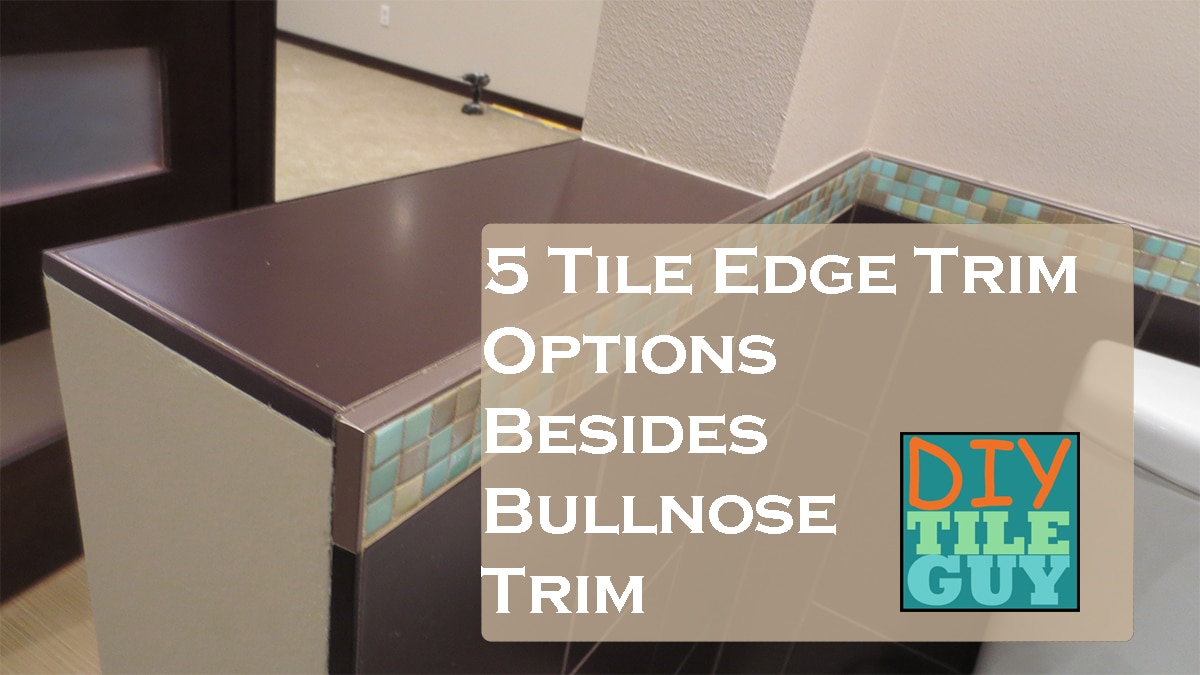
This post contains affiliate links. The site owner may earn a commission should you click on an affiliate link and make a purchase. Read more
Worse still is the DIYer tries to grout the edge to make it look more finished. PLEASE don’t do this!
If you know someone that is considering one of these two options then I’m asking you to gather close friends and family and stage an intervention. Then show them this blog post.
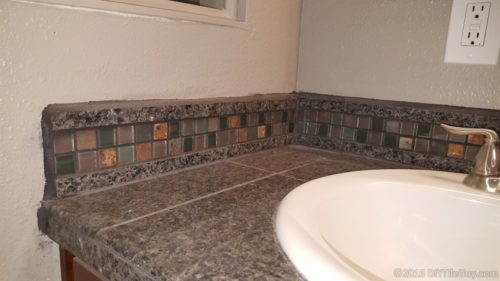
Why Not Bullnose Trim Tiles?
There’s nothing wrong with bullnose tile trim. In fact, it’s a great way to finish off the edge of the tile.
However, not everyone is crazy about bullnose trim and most people really don’t like the prices of them. Frequently, they cost the same amount of money as the field tile, and sometimes, they cost more.
Also not all tile comes in bullnose trim especially if you are looking for some of the more modern and contemporary tile looks.
A quick mention: if you are looking at subway tile make sure to read my post-Subway Tile Installation: Three Basic Tips which does talk about bullnose trim options for subway tile.
So if not bullnose, then what? Here are 5 alternatives to the classic and common bullnose tile trim.
Natural Stone tile edge trim
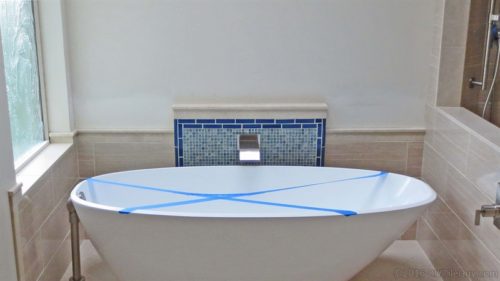
Natural stone can be polished so that the edges look finished. In some cases, the edges may not even need polishing. These types of natural stone include:
- marble
- granite
- travertine
You can buy a few pieces of travertine and cut them down into smaller sizes. Not only is this an economical use of material but it can make for an elegantly finished edge to your ceramic or porcelain wall tile.
Special equipment is required for polishing. However, you can always hire a granite fabrication shop or another tile contractor to do the polishing if it’s something that you would rather not take on.
Finally, premade trim pieces are a great option:
Glass tile edge trim
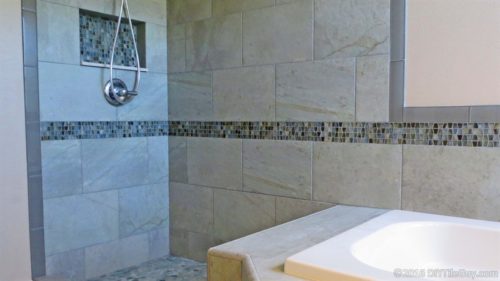
Glass is another material that naturally has a finished edge. Although, unlike natural stone, the edge is usually finished without any additional steps.
There are a lot of different glass tiles available these days.
Examples of glass tile that can be used as tile edge trim include:
If you can find one that coordinates with your tile then this may be a good tile edge trim option.
How to Cut Glass Tile: 7 Tips Revealed
Metal Profile edges
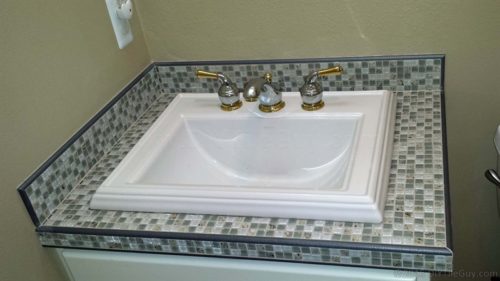
I know that just the mention of metal edge trim is going to cause some to skip right past this section. No doubt some will envision dreary hospitals and cold modern minimalist homes when thinking of metal tile trim.
But metal profiles are a fast-growing market and there are a lot more options and styles than there used to be.
Typically, the most common style is called “L” style which leaves a flat edge. These tend to be the least expensive, are widely available, and are great for achieving minimalist styling.
Additionally, squarish and rounded profiles are becoming more popular. Examples of the different styles are:
- “L” style (Jolly or Schiene in the Schluter line)
- squarish (Schluter Quadec)
- rounded (Schluter Rondec)
As for pricing, the simple “L” style is quite economical as long as you like the usual finishes:
- brushed aluminum
- chrome (coated)
- plastic
These can be as low as $1 per linear foot.
However when you get into the squarish and bullnosed shapes and/or finishes such as:
then the costs can be $30-$80 per 8 ft stick and higher.
Side note: The “L” style is commonly used for tile floor transitions, as well, such as tile-to-carpet and tile-to-hardwood transitions.
Mitering
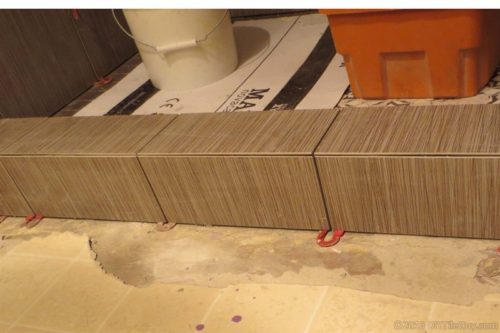
An often overlooked option is to miter the tile edges. This option is only for corners and it isn’t the most durable option.
Mitering tile on stairs is something that I don’t think is a good idea as I don’t think the corners will hold up over the long term.
A lot of the more modern tile saws will have a head that tilts so that it bevels the edge of the tile at an angle but even the old ones can work with a wedge-type guide.
This well-reviewed saw from Amazon is under $100 and has a table that allows for mitering.
DELTA CRUZER 7-INCH TILE SAW VS DEWALT D24000 | TOOL REVIEW
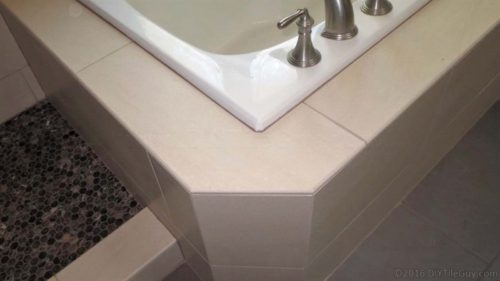
Custom Bullnose Tile
Lastly, there’s the option of making your own bullnose tiles. This requires that your tile is a through-body porcelain tile.
What that means is that instead of just a clay body with a glaze over the top the tile would have the color throughout the tile.
This allows the edge of the tile to be bullnosed and the color will be the same, or similar, to the surface. Much like a natural stone.
They make a “blade” for this that can fit on a tile saw for the DIY’ers that want to try this. I’ve had mediocre results when I tried this but it works.
Again this requires special equipment but a granite slab shop has the tools and will usually perform the service if you ask. Also simply polishing the flat edge can be done if you desire a square but finished edge.
One last option for custom bullnosing is American Bullnose that will bullnose any tile (I believe). They can bullnose the tile and glaze the edge so that it looks finished. This is for when your tile doesn’t come with its own bullnose tile edge trim.
Conclusion
So there are 5 options, plus bullnose tiles make 6, that are on the table for considering how to finish the edge of your tile.
The trend in tile choices are exploding and there just aren’t enough matching trim tiles being made. Hopefully, one of these tile edge trim alternatives will work for you.
No matter which you choose, learn how to calculate the proper amount of trim tiles for your project. And if you are measuring a shower for trim tiles you will want to see this post.